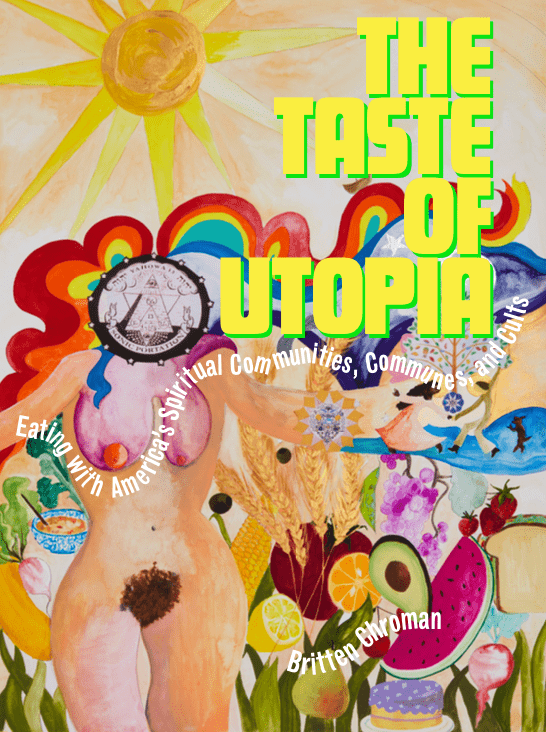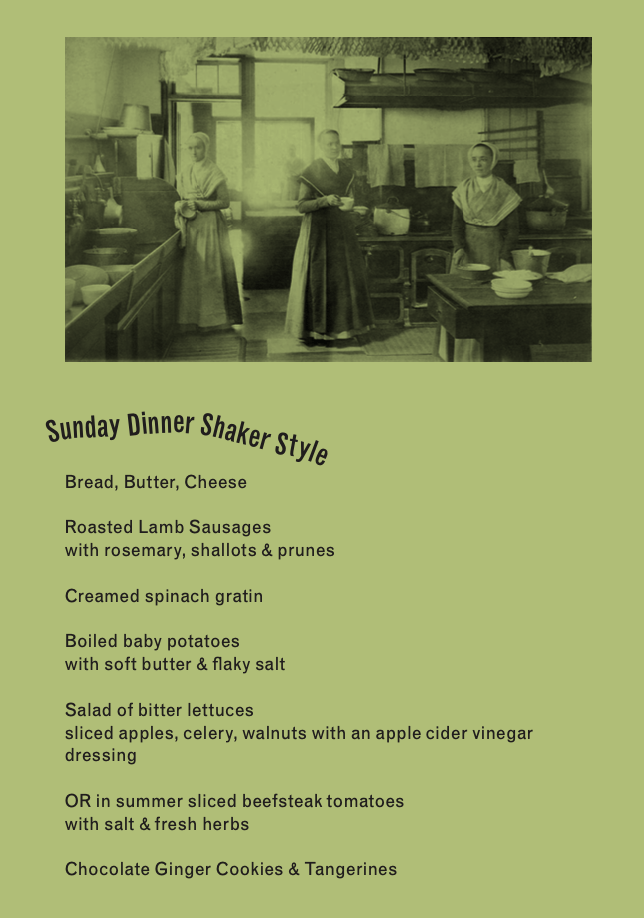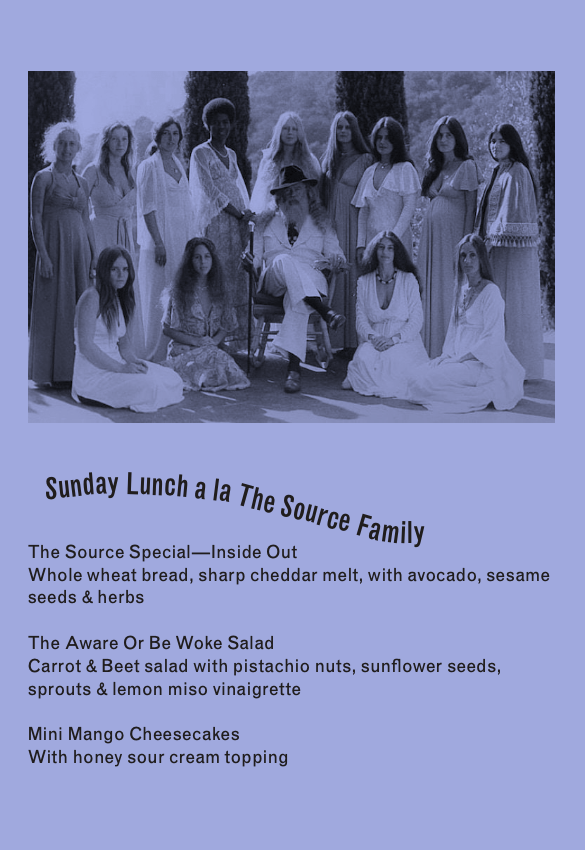
The Taste of Utopia
Eating with America’s spiritual communities, communes, and religious cults
Tucked between the high rows of corn, in the heartland of the Midwest, lives a community of people who believe that the twice-daily practice of Transcendental Meditation can change the world. This community, where I grew up, is based on the idea that if enough people simultaneously transcend it will generate a force field of positive energy powerful enough to transform the collective consciousness of the world. The community was founded in 1974, when the spiritual teacher Maharishi Mahesh Yogi and his international organization bought a dilapidated university in the Southeast corner of Iowa in a town called Fairfield. Maharishi’s followers descended on the city, buying houses, opening stores and restaurants, creating primary and secondary schools, as well as a university, and building two gold dome-shaped structures for community celebrations and group meditations. In 1983 Maharishi invited his devotees from all over the globe to come to Fairfield and meditate together, in order to generate a world-wide wave of goodwill. The organizers called the assembly ‘The Taste of Utopia.’
My parents, having moved to Fairfield from Los Angeles the previous year, participated in the assembly. At three years old I was too young to join in; I would, though, learn the children’s version of Transcendental Meditation the following year. I spent my childhood building forts in the woods, meditating with my friends at school, and eating a vegetarian diet that incorporated principles of Ayurveda—the ancient Indian science of diet, prevention, and health. In Ayurveda, food is laden with meaning: eating the right kinds of food allows the physical body to be pure enough to sustain the experience of higher states of consciousness. Meat, fish, alcohol, tobacco, garlic, onions, and mushrooms are avoided as they are heavy, slow spiritual development, and, when eaten in excess, excite anger, aggression, and lust. Milk, honey, and almonds are exalted foods, pure, easily digestible, and stimulate bliss in the body.
Decades later, I am intrigued by what it means to ‘taste utopia.’ In Maharishi’s assembly, taste was to experience, and utopia was a perfect place to live, where daily life was spiritually, socially, and materially rewarding. For me, though, the marriage of the words, ‘taste’ and ‘utopia,’ are also an opportunity to explore the role of food within utopian communities. One can hunger for God, but we all still need to eat. The necessity of eating, combined with the numerous possibilities for the preparation and consumption of food, makes foodstuffs and diet perfect vehicles for expressing ideologies, beliefs, and values. Food transmutes abstract ideas into the physical body, and constitutes the building blocks for health and well-being, states of being intimately tied to spiritual development. Food nourishes the body, but it also feeds the soul.
The centrality of food to the spiritual philosophy I grew up with has sparked my curiosity about the role of food in similar communities. My thesis project is the beginning of a book that investigates the significance of food in America’s spiritually oriented utopian communities. Each chapter of the book focuses on a specific community, telling their story and exploring how their ideologies, values, and beliefs are expressed in the way that they grow, prepare, and consume food. Each chapter includes a menu (eventually there will be recipes as well), for a meal, inspired by the foods each community eats. The three communities I research and write about here are The United Society of Believers in the Second Coming of Christ (The Shakers), Father Divine and his Peace Mission Movement, and The Source Family.
The Shakers or The United Society of Believers in the Second Coming of Christ

The Shakers, famous for the spare elegance of their architecture and their exquisitely crafted chairs, started out as a small Christian sect in England that splintered off from the “Religious Society of Friends” (The Quakers). Their leader, Ann Lee, believed she was the female counterpart of Jesus and based the Shaker doctrine on the premise that God’s divinity was both male and female.[1] In Mother Ann’s eyes, sin could be cleansed with confession and celibacy was essential for attaining spiritual perfection on earth. Along with ecstatic singing and dancing, labor was a highly valued form of worship that allowed The Shakers to continually commune with God.
Fleeing England to escape prosecution for their heretical ideas, the Shakers saw America as an unblemished garden of Eden where they could create their own version of heaven on earth. By the mid-1800s, over 6,000 Shakers lived in 18 communal villages spread across the eastern seaboard and throughout the Midwest. Agriculture was the bedrock of Shaker life. The output from Shaker farms and orchards sustained its religious communities. They had a successful nation-wide seed business and communities sold products like applesauce, cheese, maple syrup, confections, and tinctures, made from home-grown medicinal herbs.[2] For The Shakers, every aspect of labor was an ongoing act of devotion. ‘Brethren’ and ‘sisters’ poured their hearts into their work. The result was that whatever they produced, including their wholesome and nutritionally rich food, was of exceptionally high quality.
The Shakers actual diet varied by region and was similar to their rural neighbors, but it was their attention to detail, combined with their desire for material perfection, that made their meals stand out. Visitors to Shaker communities never failed to comment on the abundant, satisfying feasts, particularly the sweet, fresh butter that was the color of gold. Spinning milk into gold began with the barn for the cows. The Shaker dairies were kept spotless and their construction encouraged cross ventilation, so that no unpleasant smells could contaminate the milk.[3]
Mother Ann’s mantra, “Hands to work, hearts to God,” is expressed in the Shakers’ attitude toward the growth and preparation of food. Hard soil was something to be loving coaxed into fertility; and meals, in a life oriented towards God and stripped of superfluidity, were an opportunity for simple pleasures—a momentary pause for Believers to enjoy the sweet fruits of their labor.
Father Divine and his Peace Mission Movement

Father Divine, a black preacher who rose to fame in Harlem in the 1930s, created a nationwide movement to uplift mankind. His practical program was based on positive thinking, economic independence, cooperative living, moral integrity, and racial equality. Father Divine believed he was the incarnation God and his gospel was that heaven was here and now, on earth.
A central tenant of Father Divine’s theology was that Holy Communion was a banquet, rather than just the customary token of God’s body and blood—the wafer and the wine. The banquet table in the Peace Mission Movement was a place of nourishment, worship, and spectacle. At the height of the depression Father Divine’s free, sumptuous banquets—sometimes serving up to fifty-five different dishes—were nothing if not miraculous.[4] The banquets were spirited affairs that included singing, emotional confessions, and inspirational lectures by Father Divine. Seating at the banquets, like the Peace Mission Movement itself, was racially integrated—a radical statement in an era pre-civil rights. Equality at the table, according to Father Divine, served as a “sample and example” for equality in all other areas of life. The Peace Mission Movement also ran a number of cooperative farms in upstate New York which supplied their restaurants and groceries in urban areas with fresh, low cost produce and meat.[5]
After Father Divine’s death in 1965 his second wife, Sweet Angel, a white woman, who was his spotless virgin bride (celibacy was integral to the religion’s strict moral code) took over the Movement. In the 1970s, Sweet Angel, also known as Mother Divine, focused on the connection between diet and health and introduced her spiritual children to a macrobiotic diet.[6] Peace Mission Banquets, which originally featured southern classics such as fried chicken, biscuits, and macaroni n’ cheese, now offered a selection of dishes made with tofu, miso, and seitan.
Initially, food in the Movement symbolized abundance, freedom, and independence, concepts that refuted the subjugation and oppression of black Americans. As the Movement progressed, the properties of the foods themselves became key to living a long, holy, happy life.
The Source Family

The Source Family was a counter-culture group in the 1970s that evolved out of a hip vegetarian restaurant. In 1969, Jim Baker, a charismatic health food enthusiast, controversial character, and spiritual seeker, opened The Source restaurant on L.A.’s Sunset Strip. The restaurant served raw salads, fresh juices, and homey vegetarian entrees. The Source’s most popular dish was an opened faced avocado sandwich, piled high with alfalfa sprouts and covered in a slab of melted Swiss, Jack, or Cheddar cheese.[7] The organic produce served was purchased from the farmers market or local farms. Aside from Hollywood’s glittering stars, the restaurant attracted a group of fresh-faced youth, who, in rebelling against consumer-driven mainstream culture, were searching for a more meaningful, alternative way of life.
Jim Baker held meditation classes at The Source and began to fashion himself into the holy trinity of Father, Guru, and God. Eventually drawing in over a hundred followers he changed his name to Father Yod. Father Yod and his spiritual children lived communally in a mansion in the Hollywood Hills, started a psychedelic rock band, and experimented with a medley of religious practices, such as Kundalini breathing, astrology, Egyptian magic, tantric sex, tarot, and raw food.[8]
The restaurant supported The Source Family financially and it was also their megaphone to spread their ideology to the world. Father Yod blended esoteric dietary wisdom with nutritional knowledge culled from contemporary food gurus like Paul Bragg. His recipe for spiritual awakening started with the connection between the mind, body, diet, and health. He told his followers that their body was a vehicle that must be kept pure with a diet of whole, chemical-free, vegetarian foods.[9] Father Yod fed his ideas to the public, in the form of tasty, colorful dishes.
The Source Family also made health-food “cool.” They infused brown rice, raw vegetables, alfalfa sprouts, honey and cheese, with a generous helping of youthful radiance, mysticism, good vibrations, and rebellious electricity. Father Yod and The Source Family were pioneers of meat-free meals, and promoted seasonal, local, and organic produce. Although the cult only lasted a few years and faced a fair share of scandal, ultimately, they were influential in helping to lay the foundation of a food movement, both in terms of individual health and a growing environmental consciousness, that carries us forward today.
Conclusion
Food is a lens through which we can examine America’s spiritual utopian communities and a potent symbol of a particular groups’ values, beliefs, and principles. In investigating these groups, certain patterns repeat: a charismatic leader who embodies God, the restructuring of family, the desire for equality. And the subtle or sharp shifts in ideology—chastity vs. sex magic, soul food vs. health food, exclusion vs. inclusion—become the shades of difference in a fantastic tapestry of alternative living.
This book is about America’s rich history of communal and co-operative expression. It is about celebrating the ability to expand our interior and exterior horizons in order to live a deeply meaningful life. It is also about connecting to these communities, that rebelled against collective American norms, by cooking and enjoying meals inspired by what they ate.
Download The Tase of Utopia Zine. TasteZine4
Notes: I dedicate this project to my parents and all those who were brave enough to follow their hearts (and their charismatic leaders, gurus, and teachers) to participate in these utopian experiments.
Works cited
[1] Richard Francis. Ann the Word: The Story of Ann Lee, Female Messiah, Mother of the Shakers, The Woman Clothed with the Sun. Arcade Publishing, New York. 2000.
[2] Andrews, Edward Deming, Andrews, Faith. Work and Worship Among the Shakers: Their Craftsmanship and Economic Order. Dover Publications. 1974
[3] Ed. Glendyne R. Wergland. Visiting the Shakers: 1850-1899 Watervileit, Hancok, Tyringham, New Lebanon. Richard W. Couper Press. 2010.
[4] Brandon, Charles S. These Also Believe: A Study of Modern American Cults & Minority Religious Movements. The Macmillan Company. 1949, 1965.
[5] Mabee, Carleton. Promised Land: Father Divine’s Interracial Communities in Ulster County, New York. Purple Mountain Press. 2008.
[6] Primiano, Leonard Norman. “And As We Dine, We Sing and Praise God”: Father and Mother Divine’s Theologies of Food.” Religion, Food, & Eating in North America. Ed. Zeller, Benjamin E., Dallam, Marie W., Neilson, Reid L., & Rubel, Nora L. Columbia University Press. 2014
[7] Kaufman. Jonathan. Hippie Food: How Back-To-The-Landers, Longhairs, and Revolutionaries Changed the Way We Eat. Harper Collins, New York. 2018.
[8] Aquarian, Isis with Aquarian, Electricity. The Source: The Untold Story of Father Yod, Ya Ho Wa 13 and the Source Family. PROCESS, 2007.
[9] Father Yod. Liberation. The Source Foundation. Kilauea, Hawaii. 1970s, 2004.
